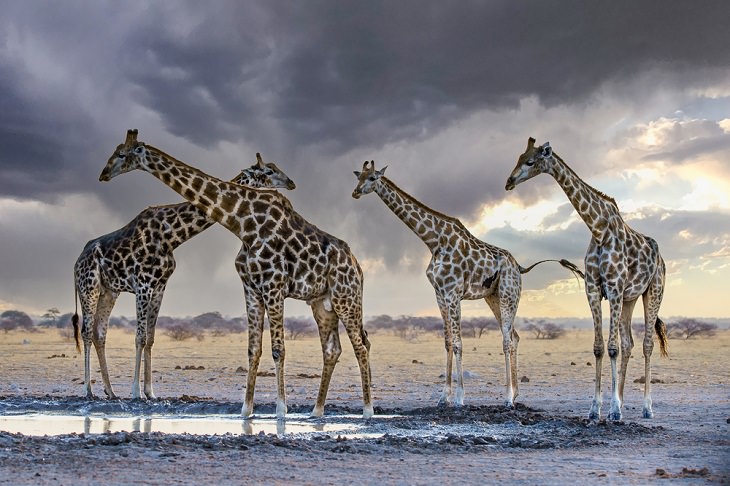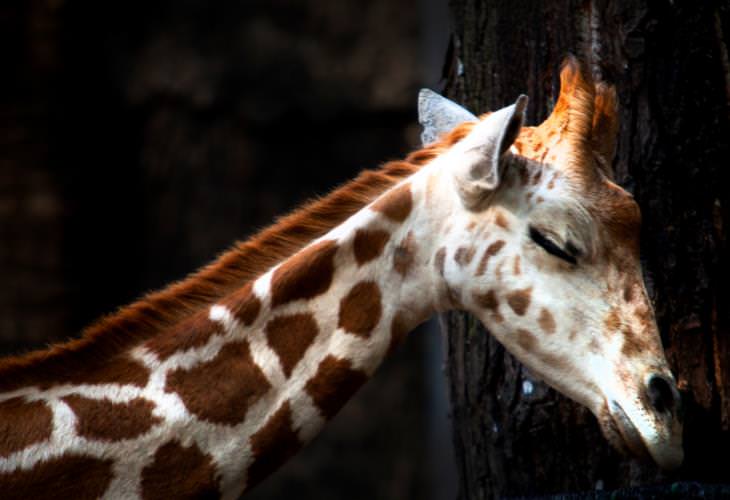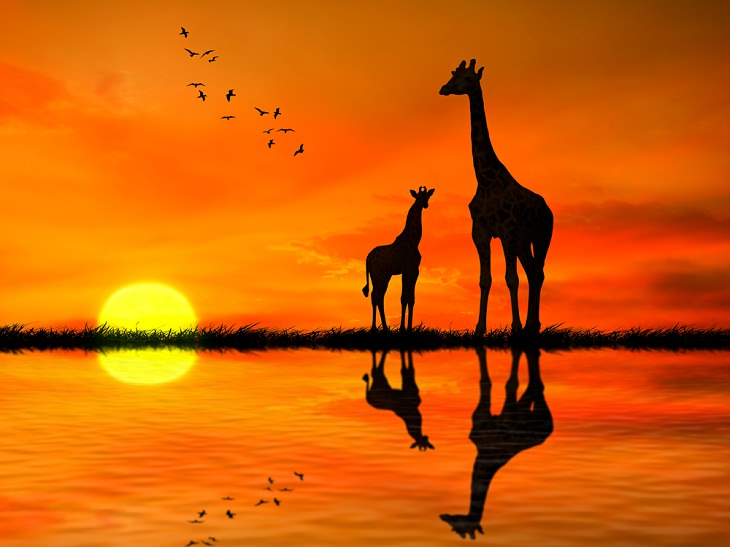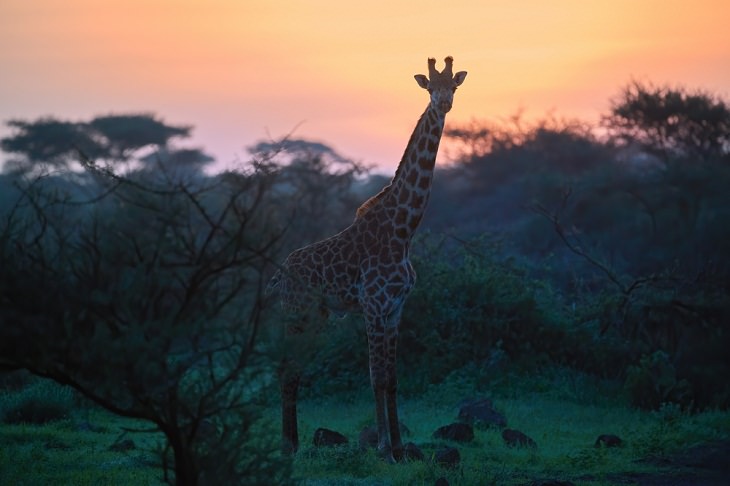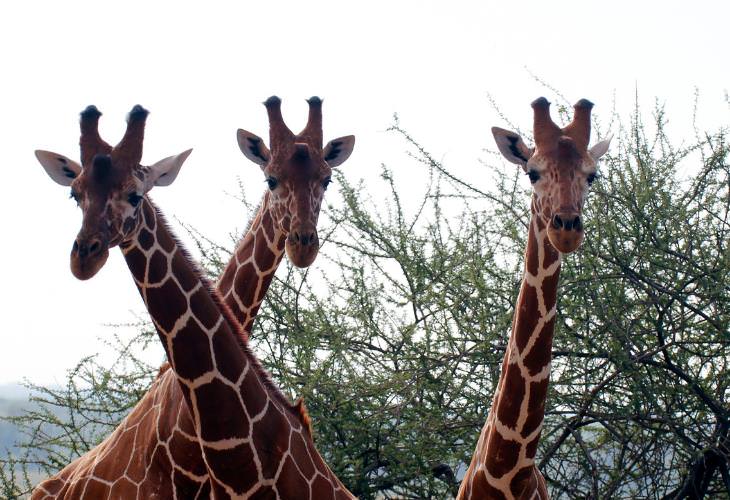Yes, that’s true! The ancient Romans had never seen a giraffe. When the animal was first brought to Europe and presented to Julius Caesar in 46 BC, the Romans were shocked to see it. They thought the curious animal looked like a camel wearing a leopard's coat. Therefore, the species came to be named Giraffa Camelopardalis. The word Camelopardalis comes from the Greek “Kamelos,” meaning “camel,” and “Pardalis,” meaning “leopard.”
2. They use their long necks to fight!
The long neck is one of the standout features of the giraffe. Their lengthy necks can be more than 2.1 meters (7 feet) long and make up almost half of their overall height. Giraffes use their long necks to reach high up into trees for food. But their necks have another important function – it is a tool for fighting! Giraffes engage in an elaborate ritual fight known as "necking" where the males of the herd swing viciously at each other with their necks to establish dominance. This usually includes head-butts, jousting, kicking, and even biting.
3. They have a huge tongue!
It's not just their neck and legs that are huge; the giraffe’s tongue is massive as well. An average adult giraffe’s tongue can measure up to 20 inches (50 cm) long, which they use to get more leverage in nibbling from the top of trees. Another peculiar attribute of the animal’s tongue is that it’s usually black, blue, or purple to help protect against the sun’s UV rays.
4. They have only one close genetic relative - the okapi
Did you know that the giraffe has only one close genetic relative - the okapi (Okapia johnstoni)? It is the only other extant member of the Giraffidae family. The okapi is also known as the forest giraffe, Congolese giraffe, or zebra giraffe. Okapis are endemic to the northeast of the Democratic Republic of the Congo in central Africa and have unique white-and-black striped hindquarters that make them look akin to zebras.
At first glance, you will not find too many similarities between a giraffe and an okapi. A closer look at the latter’s head reveals that it has very large upright ears just like its tall cousin. Okapis also have long and dark prehensile tongues like those of giraffes that allow the animal to strip the buds and young leaves off of trees.
5. There are four giraffe species, not one
Initially, all giraffes were believed to belong to a single species, but research has revealed that giraffes can be classified into four different species - the Southern Giraffe, Masai Giraffe, Reticulated Giraffe, and Northern Giraffe. They’re classified based on the color, coat patterns, and geographical regions they reside in. For example, researchers have noted the jagged lines and dark spots on the Masai giraffe and five hornlike structures on the northern giraffe. However, all four species are pretty similar for the most part.
Research also suggests that the four species might have diverged from one another about 1.5 million years ago. In comparison, humans and chimpanzees parted ways about six or seven million years ago.
6. Giraffes sleep 30 minutes a night
Giraffes rarely lay down to sleep, as they have to be constantly on alert due to the danger of predators. The African mammal normally takes micro naps while standing, just like horses, and seldom sleeps longer than five minutes. In fact, adult giraffes only get about 30 minutes of sleep a night. This is the shortest sleep requirement in the entire animal kingdom! What’s more, even when giraffes are asleep, their eyes usually remain half-open and the ears continue to twitch. Only occasionally do the giants lie down, folding their legs under their bodies. But even then, they keep their heads erect.
7. A giraffe's spots are like human fingerprints
The spots on a giraffe’s body are much like human fingerprints - no two are alike! These beautiful spots serve as camouflage for the animal when it’s quietly munching on leaves while hiding behind clumps of tall trees. More importantly, though, a very sophisticated system of blood vessels lies underneath each patch that helps regulate the giraffe's internal temperature.
8. The giraffe’s heart is humongous
A giraffe's heart is humongous – it's 2 feet (0.6 m) long and weighs about 25 lbs (11 kg), making it the biggest heart of any land mammal! The human heart, in comparison, only weighs around 300 grams. It’s so big because it has to pump blood up through the animal's long neck all the way to its brain. The giraffe’s heart pumps 60 liters (15.8 gallons) of blood around its body every minute at a blood pressure twice that of an average human. The tall animals have special blood vessels comprising of valves that help prevent the backtracking of blood due to gravity.
9. Giraffes are fairly quiet beings
They may be huge, but giraffes hardly make any noise all through the day. In case of an alarm, they use a simple snort to alert the herd of a threat. At night, they tend to produce a mild humming sound. While it’s still unclear why they hum, experts believe that it might be used as a communicative signal to locate other herd members in the dark.
10. Giraffes are exceptional pollinators
Giraffes also serve an important ecological role. As large browsers, their habitat changes since they spend a significant amount of their time feeding, pruning, and distributing seeds across the landscape. This helps keep the habitat open for other wildlife to use. In addition, giraffes serve as pollinators to many plant species, particularly the Acacia trees that have blossoms high up. As the tall mammals move from treetop to treetop, pollen gets stuck on their heads and necks and is transferred between trees, aiding in pollination.
11. Giraffes suck on animal bones
Giraffes are vegetarians, but you will be surprised to know that they suck on animal bones. You see, their skeletons do require more calcium than they can get from plants. So, when nutrients are lacking in their daily diets, giraffes lick or suck on pieces of bones they find to get the phosphorous and calcium their bodies require. Their teeth scrape bones to loosen material while their saliva dissolves nutrients. They usually drop the material once they're finished.
12. Did you know that there are white giraffes in the wild?
That’s right. An extremely rare white male giraffe calf was spotted in Tanzania’s Tarangire National Park back in 2016. Later, two more white giraffes were seen in Kenya's Ishaqbini Hirola Community Conservancy in 2017 - a baby and its equally pale mother. Unfortunately, the two were reported dead in March 2020, apparently killed by poachers. Now, the one in Tanzania is believed to be the last white giraffe in the world. To protect it from poachers, authorities have now fitted it with a GPS tracking device.
The white appearance of a giraffe is due to leucism, an abnormal condition of reduced or no pigmentation that affects various animals but is extremely rare in giraffes.
13. They're under threat today
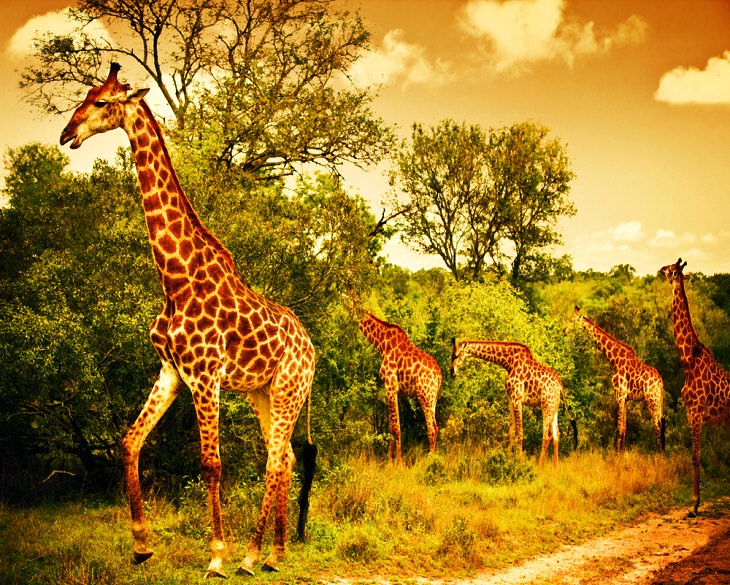
These evolutionary marvels are unfortunately under threat today, as their numbers continue to decline steadily due to poaching and habitat loss. The giraffe population in Africa has dropped by 40% in the past 30 years and has dwindled to just more than 97,000 individuals today. The animal has been recently added to the IUCN’s Endangered Species List.
Share these amazing facts with your friends and family!




